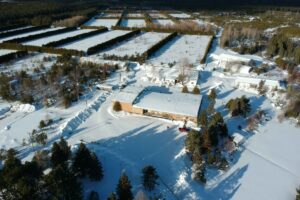Date: December 20, 2021
Author: Ken Kuchling
Several years ago I worked in the Saskatchewan potash industry where I grew my appreciation for continuous mining systems. Some of the key benefits were the high productivity per man-hour and the safe operating conditions. On a 12 hour nightshift, with a crew of 16 people we could mine over 9,000 tonnes of ore. Productivity is likely even higher now with the larger machines. Therefore, since that time, I have always kept an eye out for when similar technology can be applied in hard rock mining.
One of the research areas we are seeing these days is the development of continuous cutting technology for hard rock mine development. The idea is to replace the conventional drill & blast approach with something more efficient and safer. No need to deal with explosives, noxious gases, shatter the wall rock, or have personnel scale their way under loose conditions.
Recently I was contacted by someone associated with Robbins asking if I was aware of their MDM5000 mine development technology. I wasn’t aware of it, but I wondered if there finally is a light at the end of the tunnel.
4-rotor miner
In Saskatchewan potash the entire mining operation relies on track-mounted continuous miner technology. The miners are connected directly to the shaft area using a network of conveyors, up to 10 km worth of conveyor.
The potash miners are able to undertake both development work and production mining whilst connected to conveyor.
From time to time they will rely on shuttle cars, scooptrams, or grasshopper conveyors for small development tasks. A roadheader may also be available for localized ground stabilization.
All of this mechanical cutting is done in potash (sylvinite rock), considered a soft rock with a compressive strength of 20-40 MPa. For comparison, hard rock can have compressive strengths exceeding 250 MPa.
Two approaches in hard rock
Hard rock piloting trials are underway at a few operations, using different vendors with different equipment. These trials include companies like Komatsu, Robbins, Sandvik, and Epiroc. Each are testing their own equipment and cutting technologies.
The hard rock cutting approaches generally fall into two camps.
Roadheader style
There are the track mounted roadheader style cutters, typically with a movable arm used to shape the excavation. Any excavation shape is possible.
Tunnel Borer Style
Then there are the tunnel borer styles, where the machine propels itself with hydraulic shoes and the opening shape is based on the machine configuration. Normally a circular shaped opening is the result.
The roadheader style cutter is normally restricted to softer rock (< 50 MPa) while the tunnel borer is capable of much harder rock (200-250 MPa).
Robbins MDM5000
One system that peaked my interest is the Robbins MDM5000 because it can both cut hard rock and create a rectangular opening. Speaking with the vendor, this unit uses shoes to propel itself while cutting a rectangular shaped opening about 5m x 4.5m in size (see image). A rectangular shape is preferred to the circular opening whereby the floor invert must be backfilled to provide a level operating surface.
MDM5000 opening shape
The MDM5000 configuration and advance rate allows the installation of ground support and utilities behind the advancing face. Water sprays and dust collectors help to maintain visibility and air quality at the working face.
The Robbins unit is best suited for long straight drives although reportedly it can turn curves with 450-m radius. Tighter turns may be feasibility in the future by tweaking the machine design. Interestingly driving a drift uphill is easier than driving downhill due to the more efficient cuttings removal capability.
The MDM5000 unit can be linked to a Robbins conveyor system, which includes a head drive and an extensible belt storage unit that can feed out the conveyor belt as the machine advances forward. This operation is similar to that used in the Saskatchewan potash industry.
Robbins MDM5000
A Robbins machine has been in operation at the Fresnillo mine for several years with favorable results (check out the link here).
One nice thing about disc cutters is that they can accommodate variable rock types (softer and harder) while road headers can be hindered by hard rock zones. Roadheaders require a bit more consistency in rock quality.
Continuous cutting systems, such as the MDM5000, can be combined with vertical conveying technology, leading to safe and rapid development (>200m per month) in the right situation.
Conclusion
No doubt that we will eventually see more application of hard rock continuous cutting technology in the right situations. The Stillwater Mine in Montana has been using a Robbins tunnel borer for years for development tasks.
No matter how well these new systems perform, there will still be some limitations. This means the conventional drill and blast development will always be around. However, keep your eyes on this mining technology sector as improvements in cutter head design and equipment mobility continue to evolve.
Coincidentally International Mining (Nov-Dec 2021) recently published an in-depth article on the various systems being looked at. The link is here.
Note: You can sign up for the KJK mailing list to get notified when new blogs are posted. Follow me on Twitter at @KJKLtd for updates.
Posted in: Operations, Tech.Tagged: Mine Engineering, Mining, Underground.Last Modified: December 20, 2021
Ken Kuchling
Source link



